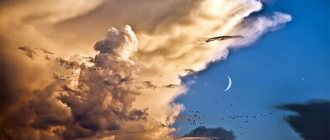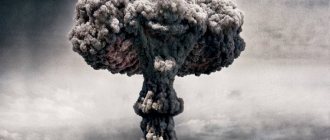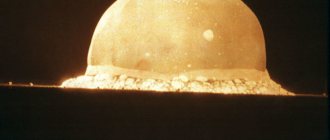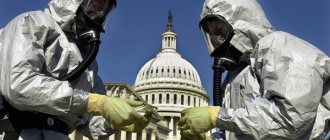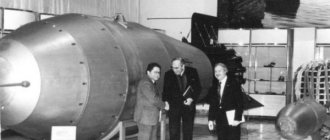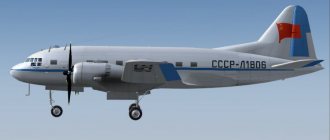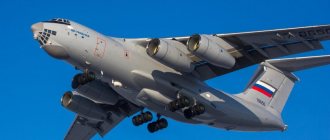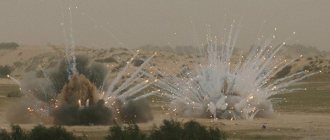Operating principle
For an airborne nuclear explosion, certain conditions must be created to provoke detonation. Typically, TNT or hexogen are used as detonators, under the influence of which a radioactive substance (usually uranium or plutonium) is compressed to a critical mass within 10 seconds, and then a powerful release of energy occurs. If the bomb is thermonuclear, then the process of converting light elements into heavier ones occurs in it. The energy released in this case leads to an even more powerful explosion.
A nuclear reactor can also be used for peaceful purposes, since fission can be controlled. For this purpose, devices that absorb neutrons are used. The processes occurring in such an installation are always in equilibrium. Even if any minor changes occur in the parameters, the system suppresses them in time and returns to operating mode. In emergency situations, elements are automatically reset to stop the chain reaction.
First experience
The energy release, discovered by Einstein and subsequently studied by nuclear physicists, interested not only scientists, but also the military. The possibility of obtaining new weapons, with the help of which it would be possible to create powerful explosions from small amounts of matter, led to experiments with radioactive elements.
The physical possibility of an explosion with a significant damaging effect was proven by the French scientist Joliot-Curie. He discovered a chain reaction that became a powerful source of energy. Next, he planned to conduct experiments with deuterium oxide, but under the conditions of World War II this was impossible to do in France, so British scientists subsequently took up the development of atomic weapons.
The first explosive device was tested in the summer of 1945 in America. By today's standards the bomb had little power, but at the time the resulting effect exceeded all expectations. The force of the explosion and the impact on the surrounding area were colossal.
Eruption in Tonga threatens the world with colder temperatures
It is known that volcanic eruptions release tens and even hundreds of cubic kilometers of ash into the atmosphere. They can rise to a height of up to fifty kilometers and stretch over a vast area, covering a significant part of planet Earth. Because of this, an anti-greenhouse effect occurs; less solar radiation reaches the surface of planet Earth. Global cooling is coming, which is also known as a volcanic winter.
This has happened several times in human history. For example, in 1815, the eruption of Mount Tambora released a cloud of ash that remained in the atmosphere for two years. In some regions of planet Earth, the temperature settled at around +5 degrees. In Europe, 1816 was called the “year without summer.” In June and July there were frosts and snow, which led to crop failure, rising grain prices and mass starvation.
results
Tests were carried out to determine the characteristics of an air-nuclear explosion. Those present subsequently described the sight they saw. They observed a bright luminous point at a distance of several hundred kilometers. Then it turned into a huge ball, a very loud sound was heard, and a shock wave rolled for kilometers. The ball exploded, leaving behind a twelve-kilometer cloud in the shape of a mushroom. At the site of the explosion, a crater remained, extending tens of meters in depth and width. The ground around him for several hundred meters turned into lifeless, pitted soil.
The air temperature during a nuclear explosion increased significantly, and the atmosphere itself seemed to become denser. Even eyewitnesses who were far from the epicenter in a shelter felt this. The scale of what they saw was amazing, since no one imagined the power they would face. It was concluded that the tests were successful.
***
On October 11, 1961, a terrible explosion occurred at the first adit, equipped in the low-mountain massif of Degelen in the very northeast of Kazakhstan. The tremors were felt tens of kilometers from the epicenter. Birds and animals scattered in fright. Few residents of this corner of Siberia, not privy to the secrets of the Soviet nuclear project, froze in bewilderment: was it really an earthquake? The surface of the mountain rose four meters. A huge cloud of dust formed above her. But the radioactive products and the fireball did not come out from under the ground.
After the explosion, dosimetrists entered the adit. They saw that the instrument boxes were intact. The specialists did not detect any radioactive contamination. The test was successful, prompting scientists to continue underground nuclear explosions. It seemed that a way out of the situation—how to continue experiments without putting people’s lives at risk—had finally been found. The power of the first underground nuclear explosion in the history of the USSR was 20 kilotons.
20 kilotons
amounted to the power of the first underground explosion in the USSR
The news from the Semipalatinsk Test Site (STS) greatly pleased the First Secretary of the CPSU Central Committee Nikita Khrushchev, who sought to overtake America on all fronts. Moreover, the Americans were the first in history to conduct underground nuclear explosions back in 1957.
Nikita Khrushchev
Photo: RIA Novosti
In fact, the Soviet government in 1958 announced a unilateral cessation of all tests and intended to adhere to the chosen line as long as the United States and Great Britain did so. However, in September 1961, at the height of the Berlin crisis, the USSR was the first to violate the voluntary moratorium. At the same time, the country was completing the creation of the world's most powerful thermonuclear bomb. Dropped from an airplane over Novaya Zemlya on October 30, 1961, it was called the Tsar Bomba. And abroad, at the suggestion of Khrushchev, she was nicknamed “Kuzka’s mother.”
60 years ago, the Soviet Union won victory after victory in the nuclear race. And at the same time, the number of people affected by radiation increased. Many of them learned that they were doomed only years later.
Damaging factors of an airborne nuclear explosion
The military immediately realized that new weapons could decide the outcome of any war. But at that time, no one had yet thought about the impact of the damaging factors of a nuclear explosion. Scientists paid attention only to the most obvious of them:
- shock wave;
- light radiation.
At that time, no one knew about radioactive contamination and ionizing radiation, although later it was penetrating radiation that turned out to be the most dangerous. Thus, if devastation and destruction were localized at a distance of several hundred meters from the epicenter of an airborne nuclear explosion, then the area of dispersion of radiation decay products extended over hundreds of kilometers. The person received the first exposure, which was subsequently aggravated by radiation fallout falling in nearby areas.
Also, scientists did not yet know that under the influence of the air shock wave of a nuclear explosion, an electromagnetic pulse is generated that can destroy all electronics at a distance of hundreds of kilometers. Thus, the first testers could not even imagine how powerful the weapon was created, and how catastrophic the consequences of its use could be.
The first space nuclear war. To be continued?..
Top-secret Operation Argus
The first high-altitude nuclear explosion in history was carried out by the Americans on August 1, 1958 over Johnston Island in the Pacific Ocean. Launching from a launch facility built on the island, the Army PGM-11A Redstone ballistic missile (serial number SS-50) lifted a W-39 nuclear warhead to an altitude of 76.8 km. The charge had a power of 3.8 Mt, but was apparently set to half power (1.9 Mt). Due to a carrier malfunction, the explosion occurred directly above the island, and not 32 km to the side, as planned. The test was codenamed Teak.
© defense.gov PGM-11A Redstone ballistic missile
On August 12, a similar charge was lifted by rocket No. CC-51 and detonated at an altitude of 42.98 km (the test took place under the code Orange). These high-altitude explosions of powerful thermonuclear charges were carried out as part of a program to create anti-missile systems and were intended to test the effectiveness of such charges in missile defense. Both bombings were part of Operation Newsreel.
Almost immediately after these two explosions, the Americans began carrying out the top-secret Operation Argus. The main purpose of this operation was to study the influence of the damaging factors of a nuclear explosion produced in outer space on terrestrial radars, communication systems and electronic equipment of satellites and ballistic missiles. At least that's what the US military now claims.
But these were rather incidental experiments. And the main task was to test nuclear charges. In addition, it was planned to study the interaction of radioactive isotopes of plutonium released during the explosion with the Earth's magnetic field.
During the tests, the Yankees tried to test the theory developed by Lawrence Radiation Laboratory employee Nicholas Christofilos. He suggested that the greatest military effect from nuclear explosions in space could be achieved by creating artificial Earth radiation belts similar to natural radiation belts (Van Allen belts).
And indeed, the experiment confirmed the theory put forward, and artificial belts actually appeared after explosions. They were discovered by instruments of the American research satellite Explorer 4, which later made it possible to speak of Operation Argus as the largest scientific experiment ever conducted in the world.
The southern part of the Atlantic Ocean between 35° and 55° south was chosen as the location for the operation. sh., which was determined by the configuration of the magnetic field, which in this area is closest to the Earth’s surface and which could play the role of a kind of trap, capturing charged particles formed by the explosion and holding them in the field. And the flight altitude of the missiles made it possible to deliver nuclear weapons only to this area of the magnetic field. In addition, the distance from traditional sea routes allowed the Yankees to hope to keep the tests secret.
To carry out explosions in space, nuclear charges of the W-25 type with a power of 1.7 kt were used, adopted for service in 1956 as the warhead of the unguided Jean air-to-air missile. The weight of the charge itself was 98.9 kg. Structurally, it was made in the form of a streamlined cylinder with a length of 655 mm and a diameter of 442 mm. Charge power - 2 kt. Before Operation Argus, the W-25 charge was tested three times and demonstrated its reliability. In addition, in all three tests the explosion power corresponded to the nominal one, which was important when conducting the experiment.
A modified X-17A ballistic missile developed by . Its length with a combat charge was 13 m, diameter - 2.1 m.
To conduct the experiment, a detachment of nine ships of the US 2nd Fleet was formed, operating under the designation of the top secret task force No. 88. To launch the missiles, the AVM-1 Norton Sound experimental vessel with a total displacement of 15 thousand tons was used. In 1945 It was put into operation as a mother ship for seaplanes. But by the early 1950s, it was converted into a floating missile test bed. It tested many missile systems, including Regulus, Polaris and Aegis.
© navsource.org
AVM-1 "Norton Sound"
The Norton Sound was cruising in the Falkland Islands. The first test was carried out on August 27, 1958. The exact time of the Yankee missile launch is still kept secret. But, taking into account the speed and altitude of the rocket, it can be approximately calculated that the launch took place in the interval from 5 to 10 minutes before the known explosion time. The first nuclear explosion in space occurred at 2:28 am. GMT on August 27 at an altitude of 161 km above a point on the earth's surface with coordinates 38.5° S. w. and 11.5° W. d., 1,800 km southwest of the South African port of Cape Town. Its power was about 1.7 kt.
Three days later, on August 30, at 3:18 a.m. the second nuclear explosion was carried out at an altitude of 292 km above a point on the earth's surface with coordinates 49.5° south. w. and 8.2° W. d.
The last, third explosion as part of Operation Argus, occurred on September 6 at 22:13. at an altitude of 750 km (according to other sources, 467 km) above the point of the earth’s surface 48.5° south. w. and 9.7° W. d. This is the highest-altitude cosmic nuclear explosion in the entire short history of such experiments. The power of the second and third explosions was also about 1.7 kt.
It is curious that all the explosions as part of Operation Argus were only part of the experiments being carried out. They were accompanied by numerous launches of geophysical rockets with measuring equipment, which were carried out by American scientists from various parts of the globe immediately before the explosions and some time after them.
Thus, on August 27, four missiles were launched: the Jason missile No. 1909 from Cape Canaveral in Florida; two Jason missiles No. 1914 and No. 1917 - from the US Ramey Air Force Base in Puerto Rico; Jason missiles No. 1913 - from the Wallops test site in Virginia. And on August 30-31, nine missiles were launched from the same launch positions. True, the explosion on January 6 was not accompanied by launches, but observations of the ionosphere were carried out using weather balloons.
But intelligence reported accurately
Soviet specialists were able to obtain information about the first of the American space explosions. On the day of the test, August 27, three geophysical missiles were launched from the Kapustin Yar test site: one R-2A and two R-5A. Measuring equipment installed on the rockets managed to detect anomalies in the Earth's magnetic field. Apparently, Soviet intelligence notified the government in advance that the Americans were preparing to test nuclear weapons in space.
Soon the American secret tests were written about in the Izvestia newspaper. Following this, on March 19, 1959, the New York Times published an article detailing what the American military was doing in the South Atlantic.
In the summer of 1962, the Americans decided to conduct new nuclear explosions in space. During Operation Fishbowl, it was planned to detonate a W-49 nuclear charge with a yield of 1.4 Mt at an altitude of about 400 km. This experiment was carried out by the American military under the code name “Starfish”. The operation started with failure. The launch of the Thor ballistic missile (serial number 193) that took place on June 20 from the LE1 site of Johnston Atoll in the Pacific Ocean was an emergency - the rocket engine was turned off at the 59th second of the flight. The officer in charge of flight safety sent a command on board six seconds later, which activated the elimination mechanism. At an altitude of 10-11 km, the rocket was exploded. The explosive charge destroyed the warhead without triggering the nuclear device. Some of the debris fell back onto Johnston Atoll, while others fell onto nearby Sand Atoll. The accident led to slight radioactive contamination of the area.
On July 9, the next launch of the Thor was carried out, which carried a W-49 type warhead with a capacity of 1.45 Mt. The explosion was carried out at an altitude of 399 km. The glow of the “man-made sun” was seen on Wake Island at a distance of 2,200 km, on Kwajalein Atoll (2,600 km) and even in New Zealand, 7,000 km south of Johnston.
© defense.gov
Thor ballistic missile
And this time, Soviet intelligence was in the know about Starfish. On May 28, 1962, the special-purpose military satellite Kosmos-5 set off to hunt for the Starfish. The spacecraft was created by specialists from OKB-1, which was headed by S.P. Korolev. The weight of the satellite was about 280 kg. The on-board equipment was supposed to determine the degree of impact of nuclear explosions on the Earth's radiation belts.
Cosmos-5 was launched into an elongated orbit (192 - 1,578 km) by a Cosmos launch vehicle from the Kapustin Yar test site. Cosmos 5 operated in space for 340 days. On May 3, 1963, it left orbit and burned up in the dense layers of the earth's atmosphere. During its flight, the satellite managed to “see” not only the explosion of “Starfish-I”, because of which, in fact, it was able to be born, but also a number of other tests: the American “Checkmate” (October 20), “Bluegill 3” Prime" (October 26), "Kingfish" (November 1), "Tightrope" (November 4), Soviet "K-3" (October 22), "K-4" (October 28) and "K-5" ( Nov. 1). All tasks assigned to Cosmos-5 were successfully completed. The collected data made it possible to provide measures to protect the on-board equipment of promising spacecraft.
In response to American nuclear tests in space, the Soviet government decided to conduct a series of such explosions during launches of ballistic missiles with nuclear charges from the Kapustin Yar test site to the area of the Sary-Shagan test site, where the “A” system was located.
The objectives of Operation K were to determine:
- the damaging effect of a nuclear explosion on the head of a ballistic missile;
- the impact of a nuclear explosion on the atmosphere;
- the impact of a nuclear explosion and disturbances in the atmosphere on the operation of radio equipment of the “A” system and on the process of pointing the B-1000 anti-missile missile at the target.
The first explosions, designated "K-1" and "K-2", were carried out within just one day - October 27, 1961. Both ammunition with a yield of 1.2 kt were delivered to the explosion sites (above the center of the experimental system "A" at the Sary-Shagan test site) with R-12 (8K63) ballistic missiles launched from the Kapustin Yar test site. The first explosion was carried out at an altitude of about 300 km, and the second at an altitude of about 150 km.
© mil.ru
R-12 medium-range ballistic missile
Nuclear view of the moon
Speaking about Soviet nuclear explosions in space, it is worth mentioning the E-3 project, which involved delivering an atomic charge to the Moon and detonating it on its surface. The author of the E-3 project was the Soviet nuclear physicist Academician Yakov Borisovich Zeldovich. The main goal of the project is to prove to the whole world that the Soviet station reached the surface of the Moon. Zeldovich reasoned as follows. The station itself is very small, and its fall onto the lunar surface cannot be detected by any terrestrial astronomer. Even if you fill the station with explosives, no one on Earth will notice such an explosion. But if you explode an atomic bomb on the lunar surface, the whole world will see it, and no one else will have any questions or doubts.
Despite numerous opponents of the E-3 project, it was still worked out in detail, and OKB-1 even made a mock-up of a station with a nuclear warhead. The container with the charge, like a sea mine, was covered with fuses to ensure an explosion in any orientation of the station at the moment of contact with the surface of the Moon.
But the mock-up was the end of the matter. Already at the preliminary design stage, quite reasonable questions were raised about the safety of such a launch. No one undertook to guarantee one hundred percent reliability of charge delivery to the Moon. If the launch vehicle had suffered an accident at the 1st or 2nd stages, the container with a nuclear bomb would have fallen onto the territory of the USSR. If the 3rd stage had not worked, the fall could have occurred in other countries.
In the end, the E-3 project was abandoned. However, it was decided to continue nuclear testing in space. During operations “K-3”, “K-4” and “K-5” on October 22, October 28 and November 1, 1962, special charges with a capacity of 300 kt were detonated at altitudes of 300, 150 and 80 km, respectively.
In June 1963, the United States proposed an agreement to ban nuclear explosions in three environments: in the atmosphere, in space and under water. The Soviet leadership almost immediately accepted this proposal. The treaty was signed in Moscow on August 5, 1963 by the foreign ministers of the USSR, USA and Great Britain.
This is the end of the history of explosions in outer space, at least until February 2022.
Types of explosions
Aerial nuclear explosions are carried out at the height of the troposphere, that is, within 10 km above the earth's surface. But besides them there are other types, for example:
- Ground or surface are carried out on the surface of the earth or water, respectively. The fireball growing from the flash has the appearance of the sun rising from the horizon.
- High altitude, carried out in the atmosphere. The luminous flash is very large in size; it hovers in the air and does not touch earth or water surfaces.
- Underground or underwater occur in the thickness of the earth's crust or at depth. Usually no flash is observed.
- Space. These occur hundreds of kilometers from the globe, outside the circumplanetary space, and are accompanied by a cloud of luminous molecules.
Different types differ not only in the flash, but also in other external characteristics, as well as damaging factors, the intensity of the explosion, its results and consequences.
Soviet high altitude tests[edit]
The Soviets conducted four high-altitude tests in 1961 and three in 1962. During the Cuban Missile Crisis in October 1962, both the US and USSR carried out several high-altitude nuclear explosions in the form of saber-rattling.
The worst consequences of Soviet high-altitude testing occurred on October 22, 1962, during the nuclear tests of the Soviet Project K (ballistic missile defense system control tests), when a missile with a 300 kt warhead exploded near Dzhezkazgan at an altitude of 290 km. The resulting EMP melted 570 km of overhead telephone line with a measured current of 2,500 A, started a fire that burned the Karaganda power plant, and disabled 1,000 km of shallow power cables between Tselinograd and Almaty.
The following year, the Partial Test Ban Treaty was adopted, ending atmospheric and extra-atmospheric nuclear testing. The 1967 Outer Space Treaty prohibited the placement and use of nuclear weapons in outer space. The 1996 Comprehensive Nuclear Test Ban Treaty prohibits all types of nuclear explosions; whether above or below ground, underwater or in the atmosphere.
Ground tests
The first bombs were tested directly on the surface of the earth. It is these types of explosions that are accompanied by a clearly defined mushroom cloud in the air and a crater extending over several tens or even hundreds of meters in the soil. A ground explosion looks the most frightening, since the cloud, hovering low above the ground, attracts not only dust, but also a significant part of the soil, which makes it almost black. Soil particles are mixed with chemical elements and then fall to the ground, which makes the area radioactively contaminated and completely uninhabitable. For military purposes, this can be used to destroy powerful buildings or objects and infect large areas. The destructive effect is the most powerful.
Surface explosions
Tests are also carried out above the surface of the water surface. In this case, the cloud will consist of water dust, which reduces the intensity of light radiation, but carries radioactive particles over vast distances, as a result of which they can fall along with precipitation a thousand kilometers from the test site.
For military purposes, this can be used to destroy naval bases, ports and ships, or to contaminate water and coastlines.
Air explosions
This type can be produced at a large distance from the ground (in which case it is called high) or at a small distance (low). The higher the explosion occurs, the less resemblance the rising cloud has to the shape of a mushroom, since the column of dust from the ground does not reach it.
A flare of this type is very bright, so it can be seen hundreds of kilometers from the epicenter. The fireball exploding from it, with a temperature measured in millions of degrees Celsius, rises upward and sends out powerful light radiation. All this is accompanied by a loud sound, vaguely reminiscent of thunder.
As the ball cools, it turns into a cloud, which creates a flow of air that picks up dust from the surface. The resulting column can reach the cloud if it is not very high above the ground. Subsequently, the cloud begins to dissipate and the air flow weakens.
As a result of such an explosion, objects in the air, structures, and people located nearby can be affected.
Beria and the dead rabbits
Khrushchev only reaped the fruits of the work of the best Soviet scientists, led by Igor Kurchatov, skillfully converting them into political points. The basis of the USSR atomic project was laid by its main opponent Lavrentiy Beria. His role in the emergence of nuclear weapons in the Union was succinctly described by Kurchatov: “If it weren’t for him, there would be no bomb.”
Academician Kurchatov
Photo: M. Kuznetsov / TASS
In the center of Semey (formerly Semipalatinsk) there still stands a three-story “Stalin” building, in which the Kremlin’s eminence grise stayed during his visits to the training ground. In the entrance there is even a carbine to which the guard dog was tied. And next to it there was a security booth.
The closer the day of the first test was, the more often the curator from Moscow came to Semipalatinsk - “all tortured, not getting enough sleep, with bags under his eyes, in a tattered raincoat.” It was rumored that because he was very busy and tired, he - which was rare for him - did not pay attention to local girls.
The leadership of the USSR became preoccupied with the issue of eliminating the American monopoly on nuclear weapons after the United States dropped two bombs on Japanese cities in August 1945. While the best minds of the country were struggling to create the first atomic charge in a nuclear center specially organized for this purpose, a test site (UP-2) was being prepared 170 kilometers west of Semipalatinsk. The location was selected according to several criteria: a vast and practically deserted area with no agricultural land was required. According to initial calculations, the diameter of the required territory should have been at least 200 kilometers and had at least some roads nearby, as well as the possibility of developing a runway for transport aircraft.
The most suitable site for a nuclear test site turned out to be the Irtysh arid steppe with rare abandoned and dry wells. In the southwest there were low mountains, in the eastern part there was the valley of the Chagan River and salty shallow lakes that dried up in summer, which were once the bottom of an ancient sea.
On this plain in 1947, the Soviet Union began one of the most ambitious construction projects in its history. In the first winter, about nine thousand military builders were involved in the work. For almost two years, soldiers and officers lived in tents and dugouts and suffered frostbite, which led to the amputation of fingers and toes. At the same time, 60 kilometers from the test site, the construction of a residential and administrative center began - today it is the city of Kurchatov in the East Kazakhstan region of Kazakhstan. The Central Headquarters of the Semipalatinsk test site was located there.
Kurchatov, 1991
Photo: Alexander Lyskin / RIA Novosti
Preparations for testing began long before the completion of the development of the first nuclear charge and were carried out with special care, since it was necessary to obtain the maximum amount of information about the processes occurring during the explosion of a projectile and the damaging factors that arise during this process. In addition, it was necessary to exclude any failures and errors in recording explosion parameters.
In total, during the preparation of the first test, 53 different aircraft, 32 armored vehicles were installed in 14 sectors of the Experimental Field at various distances from the nuclear charge, as well as various “property” of different types and branches of the military - navy, communications, chemical, engineering, logistics, etc. Further. 1,538 animals were exhibited for biomedical research, including 417 rabbits, more than 170 sheep and goats, 64 piglets, 129 dogs, 375 guinea pigs, 380 white mice and rats.
The experimental field was guarded by a special battalion consisting of four companies. Around the perimeter of the field there were 12 outposts, near each of them there was a permanent post. During the daytime, security was carried out from two observation towers, where telephone communications were extended and field telephones were installed. At night, paired patrols went out on both sides of the outpost, which were obliged, carefully watching the wire fence, to go to the border with the neighboring outpost and exchange tags there with another patrol. Near the outposts there was a perimeter defense with full-length trenches dug.
The first Soviet nuclear explosion occurred at 7:00 a.m. on August 29, 1949. The bomb's yield was more than 20 kilotons. A dazzlingly bright flash illuminated the sleepy, almost autumnal steppe. After 30 seconds, the shock wave approached the command post.
Still from the newsreel “Experience at Test Site No. 2. Testing of RDS-1”
Immediately after the explosion, 368 animals died; the survivors were taken to the vivarium the same day to monitor their condition. Military equipment within a radius of 500-550 meters was twisted and overturned. The tanks lay on their sides with their turrets torn off. True, the T-34, 500 meters from the explosion site, received only light damage. The reinforced concrete building with the overhead crane for assembling the charge also survived. 11 administrative districts of the Altai Territory were affected by the radioactive trace from the explosion.
I was born in Semipalatinsk. I was 10 years old when, on Beria’s orders, the button was pressed for the first time,” Elena Yakubovskaya, a candidate of medical sciences and a participant in the anti-nuclear international movement “Nevada-Semipalatinsk”, told Lenta.ru. - Nobody warned the people. A few minutes before the explosion, the bell rang at the school, and we were taken outside. But I had to hide it! Unfortunately, the teachers simply did not understand what was happening. I remember windows in houses were blown out, stoves were cracking. The city still has “monuments” of those times - destroyed buildings
Use for combat purposes
Hiroshima and Nagasaki are the only cities against which nuclear weapons were used. The tragedy that happened there was unparalleled.
Residents experienced the effects of an airborne nuclear explosion initiated at a short distance from the surface of the earth and classified as low. At the same time, the infrastructure was completely destroyed, about 200 thousand people died. Two thirds of them died instantly. Those who were at the epicenter disintegrated into molecules from the monstrous temperatures. The light radiation left shadows on the walls from them.
People who were further from the epicenter died from the shock wave and gamma radiation of the nuclear explosion. Some of the survivors received a lethal dose of radiation, but doctors did not yet know about radiation sickness, so no one understood why, after imaginary signs of recovery, the patients’ condition worsened. Doctors considered it dysentery, but within 3-8 weeks, patients who experienced severe vomiting died. The strange illness of survivors of the atomic bombings of Hiroshima and Nagasaki became the impetus for the beginning of research in the field of nuclear medicine.
High altitude explosions
After the bombing of Japanese cities, nuclear weapons were not used for combat purposes, but research into their capabilities continued in various places. Exercises in the atmosphere made it possible to understand what happens during an explosion at altitude. It turned out that when the center is located 10 km from the surface of the earth, a relatively small wave of nuclear explosion occurs, but the light and radiation radiation increases. The higher the explosion was made, the more ionization increases, which is accompanied by failure of radio equipment.
From the surface, it all looks like a large bright flash, followed by a cloud of evaporating molecules of hydrogen, carbon and nitrogen. The air flow does not reach the ground, so there is no dust column. There is also virtually no contamination of the territory, since at high altitude air masses move weakly, so the purpose of such a nuclear explosion can be to destroy aircraft, missiles or satellites.
Disadvantages [edit]
However, there are problems with transferring nuclear weapons to test and deployment scenarios. Due to the very large radius associated with nuclear events, it was nearly impossible to prevent indiscriminate damage to other satellites, including our own satellites. Starfish Prime
produced a belt of artificial radiation in space that soon destroyed three satellites (Ariel, TRAAC and Transit 4B all failed after passing through the radiation belt, while Cosmos V, Injun I and Telstar 1 suffered secondary degradation, due to some radiation damage to solar cells, etc .d.).
The radiation dose rate was at least 0.6 Gy/day four months after Starfish
for a heavily shielded satellite or manned capsule in polar circular Earth orbit, raising NASA concerns about its human space exploration programs.
Underground testing
Recently, there has been an agreement between countries that regulates nuclear tests and prescribes that they be carried out only underground, which helps to minimize pollution and uninhabitable areas formed around test sites.
Tests underground are considered the least dangerous, since all damaging factors affect the rocks. It is impossible to see luminous flashes or a mushroom cloud; all that remains is a column of dust. But the shock wave leads to an earthquake and soil collapse. This is usually used for peaceful purposes, to solve economic problems. For example, this can be used to destroy mountain ranges or create artificial reservoirs.
Protective measures
A nuclear explosion kills everything in its path and destroys all material objects. People caught in its epicenter have no way to escape; they instantly burn to the ground. The bomb shelter is absolutely useless in this case, since it will be immediately destroyed.
Only those who are far enough away from the explosion can escape. At a distance of more than 1-3 km from the epicenter, you can avoid the impact of the shock wave, but to do this you need to quickly find a reliable shelter as soon as a bright flash occurs. A person has from 2 to 8 seconds for this, depending on the distance. A shelter will not be directly hit by gamma radiation, but there is still a very high probability of radioactive contamination. The risk of radiation sickness can be reduced by using personal protective equipment and avoiding contact with any objects located on the premises.
Nuclear weapons are one of the most terrible inventions of mankind. Used for peaceful purposes, it can be of great benefit, but its military use poses a terrible threat to life on earth. The chain reaction that has been started cannot be stopped, so there is a nuclear disarmament treaty designed to protect the planet from disaster.
